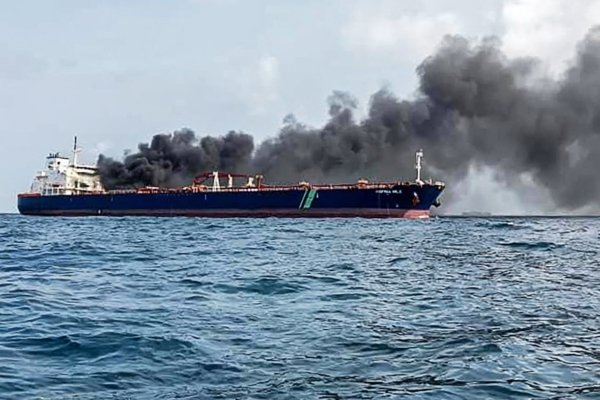On Friday, two large oil tankers collided and caught fire near Pedra Branca Island in the waters of the South China Sea, with one of the tankers owned by Chinese interests.
According to a statement from the Maritime and Port Authority of Singapore (MPA), the Singapore-flagged tanker “Hafnia Nile” and the tanker “Ceres I” flying the flag of Sao Tome and Principe collided about 55 kilometers (34 miles) northeast of Pedra Branca Island and caught fire. The MPA received a fire alert at 6:15 am on Friday.
Following the incident, the MPA requested assistance from passing vessels in rescuing the crew members. Authorities also deployed a helicopter for assistance, and all 22 crew members of “Hafnia Nile” and 40 crew members of “Ceres I” have been accounted for.
Two crew members were airlifted to the hospital, while others were also rescued, as reported by Reuters. The tanker “Ceres I” was built in 2001, and “Hafnia Nile” was constructed in 2017.
The operating company of “Hafnia Nile,” Hafnia, confirmed the collision with the Chinese-owned “Ceres I.” A tugboat was on the scene to assist the tankers, and professional salvage teams were dispatched to participate in firefighting efforts.
The exact cause of the accident is currently unknown.
“Ceres I” is a very large crude carrier, and based on the latest ship tracking data, it was transporting approximately 2 million barrels of Iranian crude oil.
According to Matt Stanley of Kpler, “Ceres I” has been involved in clandestine operations for years often turning off their AIS transponder.
Stanley mentioned that the last AIS signal sent by the vessel around March indicated it was carrying Iranian crude oil. The US has been trying to disrupt Iran’s oil trade, including imposing sanctions on ports, vessels, and refineries involved in the trade.
In relation to this recent incident, Stanley stated with confidence that “Ceres I” was carrying Iranian crude oil destined for China.
An S&P Global report in April revealed that Communist China purchases about 90% of Iran’s exported crude oil, often at discounted rates.
According to shipping data from LSEG, “Ceres I” had not moved since July 11.
Michelle Wiese Bockmann, Chief Analyst at Lloyd’s List Intelligence, noted that the area where “Ceres I” was anchored on Friday is known to be utilized by a “shadow fleet” for the illicit transfer of Iranian oil, violating US sanctions.
Bockmann stated that “Ceres I” has been involved in multiple transfer or transportation operations of Iranian oil in violation of US sanctions.
Shipping industry experts pointed out that the tanker has also been involved in transporting Venezuelan oil to China in recent years, a country also under US sanctions.
Reuters was unable to immediately reach the Chinese owners of “Ceres I” for comment.
It is estimated that as many as 850 tankers operate in this “shadow fleet,” transporting oil from countries like Iran, Venezuela, and Russia.
The environmental department of neighboring Malaysia has been alerted to prepare for possible oil spill incidents.
One of the insurers of “Hafnia Nile,” the Norwegian company Gard, stated that it is too early to assess the environmental impact. Gard is providing support to its members to deal with the aftermath of the incident.
A spokesperson for the International Maritime Organization (IMO) mentioned that the condition of the tankers or any pollution situation is currently unclear, and maritime traffic has not been affected.
The IMO spokesperson added that a salvage team has been designated and is en route to the area. Based on vessel tracking data from Kpler and LSEG, “Hafnia Nile” was carrying approximately 300,000 barrels of naphtha at the time of the incident.

